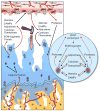Homeostatic mechanisms in articular cartilage and role of inflammation in osteoarthritis
- PMID: 24072604
- PMCID: PMC3989071
- DOI: 10.1007/s11926-013-0375-6
Homeostatic mechanisms in articular cartilage and role of inflammation in osteoarthritis
Abstract
Osteoarthritis (OA) is a whole joint disease, in which thinning and disappearance of cartilage is a critical determinant in OA progression. The rupture of cartilage homeostasis whatever its cause (aging, genetic predisposition, trauma or metabolic disorder) induces profound phenotypic modifications of chondrocytes, which then promote the synthesis of a subset of factors that induce cartilage damage and target other joint tissues. Interestingly, among these factors are numerous components of the inflammatory pathways. Chondrocytes produce cytokines, chemokines, alarmins, prostanoids, and adipokines and express numerous cell surface receptors for cytokines and chemokines, as well as Toll-like receptors. These receptors activate intracellular signaling pathways involved in inflammatory and stress responses of chondrocytes in OA joints. This review focuses on mechanisms responsible for the maintenance of cartilage homeostasis and highlights the role of inflammatory processes in OA progression.
Figures


References
-
- Blagojevic M, Jinks C, Jeffery A, Jordan KP. Risk factors for onset of osteoarthritis of the knee in older adults: a systematic review and meta-analysis. Osteoarthritis Cartilage. 2010;18(1):24–33. - PubMed
-
- Felson DT, Lawrence RC, Dieppe PA, et al. Osteoarthritis: new insights Part 1: the disease and its risk factors. Ann Intern Med. 2010;133(8):635–646. - PubMed
-
- Mahjoub M, Berenbaum F, Houard X. Why subchondral bone in osteoarthritis? The importance of the cartilage bone interface in osteoarthritis. Osteoporos Int. 2012;23(Suppl 8):841–846. - PubMed
Publication types
MeSH terms
Substances
Grants and funding
LinkOut - more resources
Full Text Sources
Other Literature Sources
Medical

